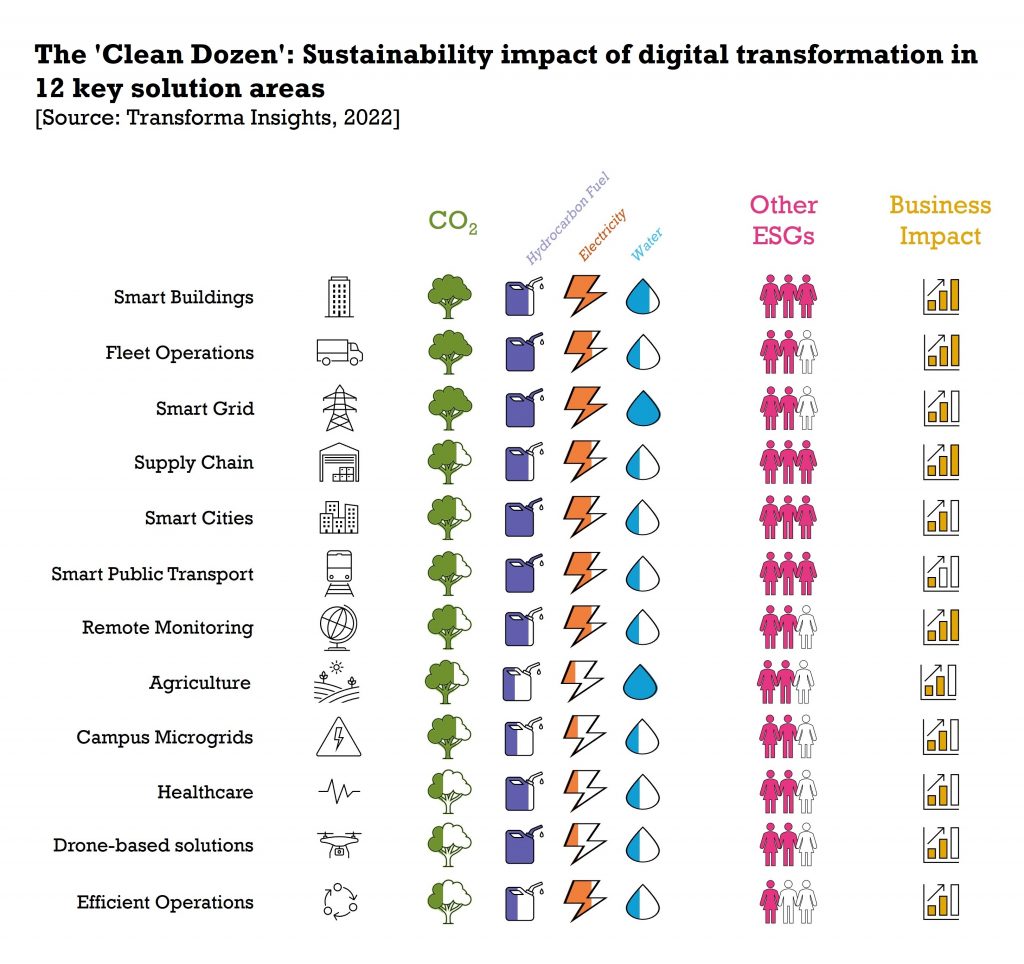Enterprises are increasingly focusing attention on ESG (Environmental, Social and Governmental) goals as a mechanism for improving their perception amongst investors, employees and other stakeholders. A key part relates to sustainability and the reduction of the organisation’s environmental impact. The application of new technologies, particularly the Internet of Things and Artificial Intelligence, can have a significant impact on reducing an organisation’s carbon footprint, both directly through lower hydrocarbon fuel use and through reducing electricity consumption, say Matt Hatton, founding partner and Suruchi Dhingra, research manager of Transforma Insights.
In its latest research, Transforma Insights has identified a ‘clean dozen’ solution areas that will substantially help enterprises meet their ESG goals. In this article we focus on fuel and electricity consumption, which have a direct impact on an enterprise’s carbon footprint.

The reasons for considering these two elements, electricity and fuel consumption, together is that there is a lot of overlap between the two, for several reasons. The first is that electricity is often generated from burning hydro-carbon fuels, so it’s important to consider those to together. More importantly, the consumption of fuel is predominantly done by motor vehicles, which will, over time, shift to becoming electric vehicles. This will move the consumption of fuel to that of energy. The ESG impact will therefore change. The extent of that change will depend on how the electricity is generated, be it by nuclear power stations, wind turbines or coal-fired power-stations.
The Fleet Operations function relates to all aspects of operating and maintaining a fleet of vehicles while enhancing driver efficiency. The impact on fuel consumption from such systems can be substantial. Fleet telematics can reduce fuel consumption by 15%, and thus the total cost of running a fleet by 6%. There are also indirect opportunities too. Tyre pressure monitoring can also have a very positive impact, for instance preventing the 8% fuel lost that can result from under-inflated tyres. Higher fuel costs in 2022 will doubtless have focused the attention of many fleet managers on realising these benefits, for economic if not for environmental reasons.
Another good example of indirect savings comes from Supply Chain, which includes a range of solutions where technologies are applied to improve the workings of a transport, logistics and distribution network. There are some direct factors, for instance container tracking resulting in 2-3% savings on fuel. Indirect savings can be even more substantial. For instance, the average company using an inventory management system can make space savings of 20%, resulting in commensurate savings on electricity.
Smart Cities includes numerous use cases that can provide substantial benefit for cities, including smart streetlights, road traffic control systems, and parking space monitoring. The implementation of smart street lighting can typically save cities 20% on their electricity costs. According to Transforma Insights analysis, smart lighting can save between 17kg and 34kg of CO2 per street light per year. Meanwhile parking space monitoring such as that implemented by SFpark in San Francisco, can reduce fuel consumption in idling and in searching for parking spaces by up to 40%. And traffic monitoring systems can save on average 2% of fuel for every journey across the city.
Another municipal service that can have a major sustainability impact is Smart Public Transport, which includes systems for operating public transport more efficiently. Overall Transforma Insights estimates that fuel consumption, and CO2 emissions, can be reduced by 10-15% by such initiatives.
Smart Buildings is one of the top solution areas, comprising monitoring and control of building systems including lighting, HVAC, windows, blinds, curtains, and doors, based on occupancy levels of areas within a building. With buildings accounting for 55% of global energy consumption, efficiency savings here can have global impact. The application of IoT could cut energy consumption by as much as 10%, including a 35-40% saving on lighting and 20-25% savings on HVAC.
Smart Grid, which includes all aspects of grid operations including smart metering and management of transmission and distribution networks, is the other major area where energy savings can have a huge impact. Smart metering reduces consumption by 3-5% for consumers and 10-12% for enterprises. Meanwhile electricity grid operations can typically reduce electricity lost across the distribution network by 7-8%.
The report further examines solution areas including Campus Microgrids, Remote Monitoring & Maintenance, Smart Healthcare, Drone-based Solutions, Smart Agriculture and Efficient Operations. All of these have some further impact on energy and fuel use but not as marked as the examples presented above.
This article was written based on Transforma Insights’ recently published ‘Sustainability enabled by digital transformation’ report. The 112-page report focuses on the sustainability benefits of a range of digital transformation (DX) solutions, and related ESG (Environmental, Social, and Governance) benefits. Overall, the report identifies twelve key areas (the ‘Clean Dozen’) where digital transformation can significantly help an organisation achieve sustainability goals. These include Fleet Operations, Supply Chain, Smart Cities, Smart Grid and Smart Buildings. For each of those solution areas, the report draws on a wide range of case studies to identify the impact that implementation of such projects might have for enterprises, including reducing electricity, fuel and water consumption, in meeting wider ESG goals, and in terms of business impact.
The authors are Matt Hatton, founding partner and Suruchi Dhingra, research manager of Transforma Insights.
Comment on this article below or via Twitter: @IoTNow_OR @jcIoTnow






